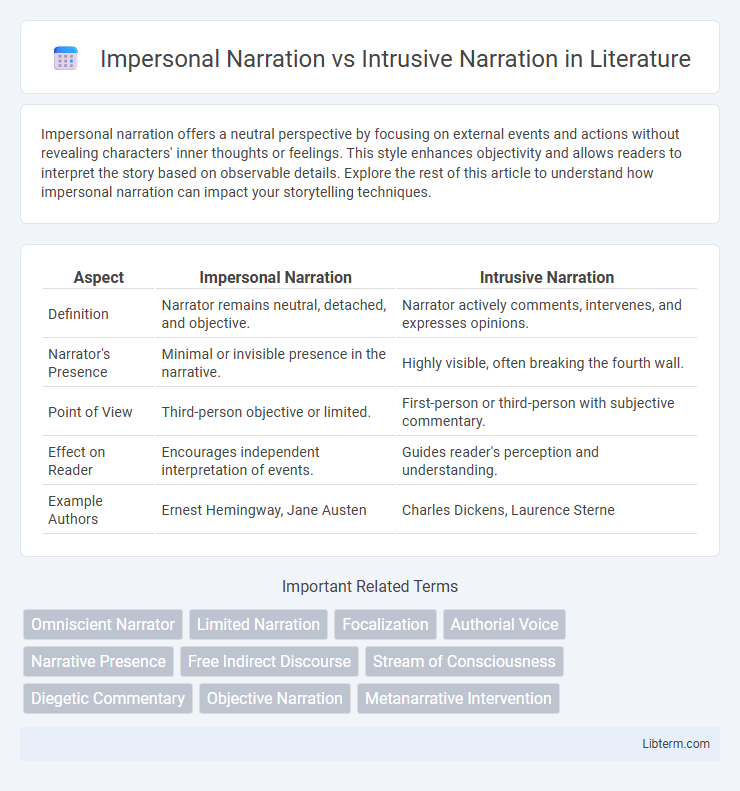Impersonal narration offers a neutral perspective by focusing on external events and actions without revealing characters' inner thoughts or feelings. This style enhances objectivity and allows readers to interpret the story based on observable details. Explore the rest of this article to understand how impersonal narration can impact your storytelling techniques.
Table of Comparison
| Aspect | Impersonal Narration | Intrusive Narration |
|---|---|---|
| Definition | Narrator remains neutral, detached, and objective. | Narrator actively comments, intervenes, and expresses opinions. |
| Narrator's Presence | Minimal or invisible presence in the narrative. | Highly visible, often breaking the fourth wall. |
| Point of View | Third-person objective or limited. | First-person or third-person with subjective commentary. |
| Effect on Reader | Encourages independent interpretation of events. | Guides reader's perception and understanding. |
| Example Authors | Ernest Hemingway, Jane Austen | Charles Dickens, Laurence Sterne |
Defining Impersonal Narration
Impersonal narration presents the story through an objective, neutral voice that refrains from revealing the narrator's personal opinions or emotions, allowing the events and characters to stand independently. This narrative style emphasizes external actions and dialogues over internal commentary, creating a distance between the narrator and the story. Impersonal narration contrasts with intrusive narration, where the narrator actively interjects with personal insights or judgments, shaping the reader's interpretation.
Exploring Intrusive Narration
Intrusive narration directly addresses the reader, breaking the fourth wall to provide commentary, opinions, or insights that shape the interpretation of the narrative. This technique often reveals the narrator's personality, biases, and editorial control, enriching the text with a subjective layer that challenges the notion of an objective storyteller. Exploring intrusive narration highlights its role in creating a dynamic relationship between the narrator and the audience, enhancing thematic depth and reader engagement.
Key Characteristics of Impersonal Narration
Impersonal narration maintains an objective tone by presenting events and characters without the narrator's personal opinions or emotions, ensuring a neutral and unbiased storytelling approach. It relies on external descriptions and observable facts rather than internal thoughts or feelings, allowing readers to interpret the narrative independently. This style often employs third-person limited or third-person objective perspectives, emphasizing detachment between the narrator and the characters.
Features of Intrusive Narration
Intrusive narration is characterized by the narrator's overt presence, providing explicit commentary and direct addresses to the reader, which shapes the interpretation of the story. This narrative style breaks the fourth wall, offering subjective insights, opinions, and reflections that influence the reader's understanding and emotional response. Unlike impersonal narration, intrusive narration emphasizes the narrator's voice as an active participant in the narrative rather than a detached observer.
Narrative Voice and Distance
Impersonal narration employs a neutral, detached narrative voice that maintains distance from characters' emotions and thoughts, providing an objective overview of events. Intrusive narration features a prominent, subjective voice that directly addresses the reader, often commenting on the story, thus reducing narrative distance. The key difference lies in narrative voice presence and the degree of emotional or interpretive proximity to the characters and plot.
Reader Engagement and Perspective
Impersonal narration maintains a neutral, observational perspective that allows readers to interpret events independently, fostering engagement through subtle immersion. Intrusive narration breaks the fourth wall by directly addressing the reader, shaping their thoughts and emotions with a conversational tone that increases involvement. Reader engagement varies as impersonal narration encourages active interpretation, while intrusive narration guides perspective through explicit commentary.
Effects on Storytelling Tone
Impersonal narration creates an objective, distant tone that allows readers to interpret events without authorial bias, enhancing realism and neutrality in storytelling. Intrusive narration introduces the narrator's personal opinions and commentary, shaping the tone with subjective judgment and guiding readers' emotional responses. The choice between these narration styles significantly influences the reader's engagement and the overall narrative voice, impacting how themes and characters are perceived.
Famous Examples in Literature
Impersonal narration, exemplified by Jane Austen's *Pride and Prejudice*, maintains an objective voice that focuses on characters' actions without direct authorial commentary, creating a sense of realism. Intrusive narration, as famously employed by Charles Dickens in *David Copperfield*, features the author's direct interjections and opinions, guiding readers' interpretations and adding a personal tone. Both techniques shape narrative engagement, with impersonal narration fostering immersion and intrusive narration enhancing author-reader connection.
Strengths and Weaknesses
Impersonal narration offers objectivity and a broader perspective by limiting authorial presence, which allows readers to form independent interpretations but can reduce emotional engagement and character intimacy. Intrusive narration strengthens reader connection through direct commentary and insight, enriching thematic depth and humor, yet risks disrupting narrative flow and diminishing subtlety. Balancing these techniques enhances storytelling by leveraging impersonal narration's neutrality with intrusive narration's expressive voice.
Choosing the Right Narrative Style
Choosing the right narrative style depends on the desired reader experience and storytelling goals; impersonal narration offers a detached, objective perspective that allows readers to interpret events independently, ideal for fostering neutrality and subtlety. Intrusive narration, by contrast, directly addresses the audience or comments on the story, creating intimacy and guiding interpretation, which works well for subjective or reflective narratives. Writers should evaluate how much narrative presence enhances thematic depth and emotional engagement to determine the optimal approach.
Impersonal Narration Infographic

 libterm.com
libterm.com